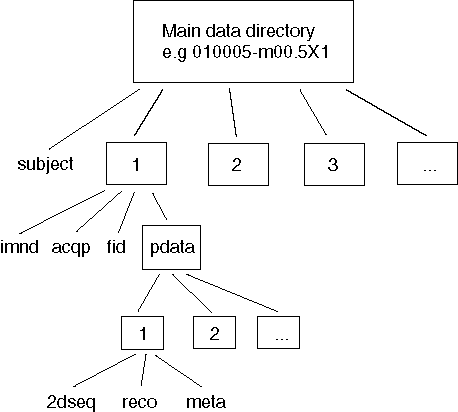Bruker data format
This is a short page briefly introducing the Bruker data format. The format is illustrated in the following graphic:

For the Bruker format, a single scanning session is stored in its own directory. The directory is named according to the subject name or number, as typed in by the scanner operator. The directory name usually specifies the subject name/number and which session this is for that subject. Thus, a typical directory name would be
010005-m00.5X1
where '010005' is the WBIC subject number of the subject, the 00 of 'm00' means this is the first scanning session that subject has had at the WBIC (m01 would be the second session), and '.5X1' is a code specifying the day of the study (5X) and the number of the session for that subject, on that day (1). The first two letters specify the day, since some arbitrary base date - set in the Bruker software (thanks to Andrew Janke for help on the code system).
The WBIC number (e.g. 010005) is turn is made up of the year the subject was first scanned (01 = 2001) and where that subject is in the sequence of new numbers allocated (5 = 5th subject in the year 2001 who has needed a new subject number).
This data directory (e.g 010005-m00.5X1) is in turn stored initially in the account space of the account for which the data was collected. For example, for scans collected using the cbu account, the data is stored in:
/imports/pvData0/cbu/nmr
on the WBIC system, but data collected with the 'guest' account is stored in:
/imports/pvData1/guest/nmr
Within the session directory (e.g 010005-m00.5X1), there are:
a text file, named 'subject' ( example subject file )
- A subdirectory numbered 1, 2, 3 etc, for each saved run of data acquisition in that session
Within each of the run directories (e.g. 010005-m00.5X1/5) there are the following:
an 'imnd' text file ( imnd example ), containing parameters used in setting up and acquiring the data from the scanner
an 'acqp' (ACquisition Parameter) text file ( acqp example ), with further details of the acquisition parameters used for that run
- an large 'fid' file, that contains the raw, unreconstructed MR Free Induction Decay data
- a subdirectory 'pdata' (Processed Data), that contains any reconstructions of the data into images
- various other files, including the 'pulseprogram' and 'grdprog.r' gradient programs
Within each of the 'pdata' subdirectories (e.g 01001-m00.5X1/5/pdata), there are numbered subdirectories (1,2,3 etc) for each new reconstruction of the raw data into images. There is usually only one such reconstruction, in subdirectory '1'.
Within each reconstruction directory (e.g 01001-m00.5X1/5/pdata/1), there are:
a '2dseq' file. This is the 3D (structural etc) or 4D (FMRI) image file. It is simply a binary block of data, which could simply be renamed as 'myscan.img' to make an acceptable Analyze .img file (see the Analyze format page ).
a 'reco' text file ( reco example ), containing some details of the reconstruction.
a 'meta' text file ( meta example ), which I think contains information for the display of the 2dseq file within ParaVision
- a 'd3proc' file, containing image size definition parameters, inter alia.
